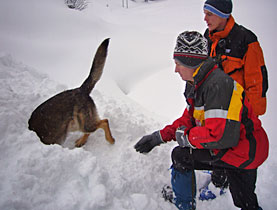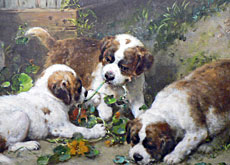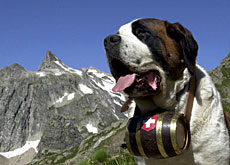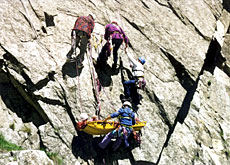On the trail of the Alps’ four-legged heroes

It is absolutely silent inside the man-made dugout in the snow but gradually the sound of a dog barking becomes more and more audible.
Muffled voices follow and then there is the sweet sound of scraping snow as a four-legged rescuer breaks through the hole cover and announces his discovery to his human trainer.
The smell of a sausage treat inside is too much for the Labrador to resist and he jumps into the hole, already snug with two people.
It’s one of series of training exercises that dogs and their handlers must undergo to become a bonafide team in the Swiss Alpine Rescue service.
On this training day at the Hoch-Ybrig resort in the Swiss Alps there are five men with their dogs going through practice runs in heavily falling snow. Inja, a five-year-old Poodle Pincher, is at the peak of her career but must still be routinely tested by her owner Marcel Meier.
Meier joined 21 years ago in part as a debt of gratitude to the Rega air ambulance service which helped bring his wife’s premature babies to a hospital in time to save their lives.
“If I didn’t have the rescue helicopter they would have died,” he told swissinfo.
“The other reason is that I have been a mountain guide for a long time. I have worked with dogs since I was 15, so I brought these two things together.”
Sensory powers
Meier oversees the technical operations and training of the mountain rescue service’s 135 volunteer dog handling teams. In the Swiss training system dogs and their owners must progress through several test stages to qualify.
At the first level, a dog is trained to find its owner who has been hidden in the snow. At the next level he must find two people. At level three the team is tested and if they pass, will qualify to join the ranks of those on call 24-hours a day in the winter season. Crucially, they need to be available to join search teams within five minutes.
The dog teams are first on the scene with the air ambulance. The canine’s advanced sense of smell – a human scent can be detected up to five metres below fresh powder snow – is the quickest way to track an avalanche victim who is not wearing a radar device.
Speed is vital for survival. An avalanche victim found within 15 minutes of being buried in snow has a 90 per cent chance of survival. Once the clocks ticks past 30 minutes, their chances drop to 30 per cent.
“I think the dogs are very important in finding missing people,” Meier says. “If you have a shovel and a receiver then you have a chance of being found. If you don’t, then you need the dogs. They are your only hope.”
After three years of training a dog will work for an average of five years, although Labradors can work up to 12 years. German Shepherds, the same size as the famous St Bernard rescue dog, are by far the most popular breed, but Labradors and Border Collies are also used.
Need for recruits
While most of the country has enough rescue dog teams to deal with emergencies, parts of canton Valais are experiencing a worrying dearth in new recruits.
Upper Valais has had fewer recruits than usual and this year the French-speaking part of Valais lost seven dog handlers due to professional reasons. They were replaced by just two new volunteers.
Pierre Theytaz, the canine avalanche rescue team coordinator for the area, says the canton’s size is to blame, with barely enough on-call volunteers spread evenly around and able to reach rescue operations as quickly as needed.
It is a major issue considering around half of all Swiss avalanche incidents take place in the canton.
“The problem with the avalanche on-call system is that you have to be very quick. We work with rescue teams who leave immediately. You have to be available within three to five minutes,” Theytaz told swissinfo.
“During the week that you are on call you either have to bring your dog to work or leave him in the car.”
Sounding the alarm
Theytaz notes that any further drops in numbers would affect the quality of service on offer in the area. A recruitment drive is now beginning for another ten recruits for 2009.
“For this season it will be alright, we can guarantee the service as it is. But we have sounded the alarm a little in the hope of recruiting people for next year.”
The fact that candidates must match up to a series of requirements doesn’t help the situation, he adds. As well as flexibility at work, volunteers must also be good skiers, be located in alpine regions, have good fitness levels and of course, own a dog.
“All that together means it really has to be a passion,” he explains, adding that for a dog owner it can also be very satisfying and provide a unique way of enabling a dog to be of service.
Joining the regulars on the training day exercise back in Hoch-Ybrig are two new recruits who have brought their dogs along to try it out for a day.
One, Martin Huwiler, a farmer, sits in the snow dugout with me waiting to be rescued as part of the tests and admits he is not sure if this is for him. His young Labrador puppy, Pedro, curls up into a black ball in the snow trying to keep warm.
“I have friends and family who go skiing and I think maybe one day I can help them,” he says. “But I think you really need to have a feeling for it.”
swissinfo, Jessica Dacey in Hoch-Ybrig
It is impossible to determine when dogs started being used to rescue avalanche victims. The Swiss Alpine Rescue service says it is not certain that the renowned St Bernard dog, Barry, was the first. Barry is thought to have kept watch over the St Bernard pass in the 1800s and saved around 40 people. His fame spread throughout Europe in the 19th century and he later became the epitome of the rescue dog.
In 1937 a group of 18 schoolboys was hit by an avalanche in the Bernese Oberland. While rescuers managed to find 17 of the group, one was still missing. The search was on the point of being called off when a local mixed breed dog known as Moritzli drew the rescuers’ attention to a particular location in the snow. After testing the ground with prods the 18th member of the group was found and resuscitated.
A dog specialist, Ferdinand Smutz, heard the tale and in 1940 presented the idea of training dogs to the army. The army undertook training during the Second World War in order to trace avalanche victims and in 1945 the Swiss Alpine Club took over specialised canine rescue training.
The Swiss cabinet decided in 1951 that dogs should be trained and yearly courses organised by the Swiss Alpine Club.
During the 1950s dogs were first parachuted into rescue spots from airplanes and they were later carried by helicopter to alpine searches.
The Swiss Alpine Rescue service is in charge of rescue operations for people in the Alps and is manned by volunteers. It has been saving people for more than a century, but started at first by saving its own members, before expanding to become an organisation covering all the country.
The service depends on contributions from supporters and the cantons where it operates for its funding.
The canton of Valais decided to form its own rescue service in the 1990s, and opted to merge all emergency services, apart from police, so they could be contactable on one main number.
There are 135 dog teams run by the Swiss Alpine Rescue service, including five women dog handlers. There are 35 people in training and there were 16 new recruits last year. There are around another 25 dog rescue teams in the French-speaking part of Valais and more in the Upper Valais.

In compliance with the JTI standards
More: SWI swissinfo.ch certified by the Journalism Trust Initiative




You can find an overview of ongoing debates with our journalists here . Please join us!
If you want to start a conversation about a topic raised in this article or want to report factual errors, email us at english@swissinfo.ch.